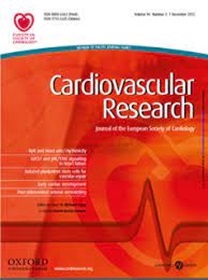Sirtuin-1直接结合并使肝脏PCSK9去乙酰化,从而促进LDL受体降解的抑制。
IF 13.3
1区 医学
Q1 CARDIAC & CARDIOVASCULAR SYSTEMS
引用次数: 0
摘要
aimslow -密度脂蛋白(LDL)-胆固醇在动脉粥样硬化性心血管疾病(ASCVD)发病机制中起因果关系。细胞内NAD +依赖的去乙酰化酶Sirtuin-1 (SIRT1)的药理激活通过增加肝脏ldl -受体(LDLR)表达来降低血浆ldl -胆固醇水平,这与动脉粥样硬化保护作用有趣地相关。最近的研究已经确定了SIRT1在血浆中的存在,然而,它的作用仍然难以捉摸。我们发现,与野生型对照相比,动脉粥样硬化小鼠的血浆SIRT1水平降低,旨在研究全身SIRT1恢复对动脉粥样硬化小鼠脂质代谢和斑块负担的治疗潜力,并解剖其潜在的分子机制。方法与结果12周龄载脂蛋白e缺乏(ApoE-/-)小鼠随机饲喂高胆固醇饮食(1.25% w/w),接受重组小鼠SIRT1(rmSIRT1)治疗(n = 6;0.3 mg/kg BW i.p.)或车辆(n = 6;PBS)每3天,持续4周。在ApoE-/-小鼠中,提高全身SIRT1水平可增加肝脏LDLR蛋白表达,降低血浆ldl -胆固醇水平并减少斑块进展。然而,rmSIRT1治疗并没有改变肝蛋白转化酶枯草素/ keexin 9型(PCSK9)的表达,但显著增加了其去乙酰化水平。质谱分析显示,在机制上,rmSirt1直接与肝脏PCSK9结合,从而促进PCSK9去乙酰化,涉及3个位点,即Lys243、Lys421和Lys506。体外诱变三重去乙酰化模拟物(3KR)降低了sirt1诱导的PCSK9活性,125I-LDL与肝脏LDLR的细胞结合和关联增加证明了这一点。最后,评估急性冠状动脉综合征患者的血浆SIRT1和PCSK9的基线水平。在这些患者中,血浆SIRT1水平与PCSK9呈负相关,高SIRT1水平可降低主要不良心血管事件(MACE)的风险。结论sirt1直接结合肝脏PCSK9,通过去乙酰化降低其活性,从而通过上调肝脏LDLR增强ldl -胆固醇清除率。提高循环SIRT1在小鼠中具有动脉粥样硬化保护作用,高水平SIRT1与ASCVD患者预后改善相关。本文章由计算机程序翻译,如有差异,请以英文原文为准。
Sirtuin-1 directly binds and deacetylates hepatic PCSK9 thereby promoting the inhibition of LDL receptor degradation.
AIMS
Low-density lipoprotein (LDL)-cholesterol is causally involved in atherosclerotic cardiovascular disease (ASCVD) pathogenesis. Pharmacological activation of the intracellular NAD + -dependent deacetylase Sirtuin-1 (SIRT1) reduces plasma LDL-cholesterol levels by increasing hepatic LDL-receptor (LDLR) expression, which intriguingly associates with atheroprotective effects. Recent studies have identified the presence of SIRT1 in plasma, however, its effects remain elusive. We found that plasma levels of SIRT1 to be decreased in atherosclerotic mice compared with wild-type controls and aimed to investigate the therapeutic potential of systemic SIRT1 restoration on lipid metabolism and plaque burden in atherosclerotic mice and dissect the underlying molecular mechanisms involved.
METHODS AND RESULTS
Twelve-week-old apolipoprotein E-deficient (ApoE-/-) mice fed a high-cholesterol diet (1.25% w/w) were randomized to receive recombinant murine SIRT1(rmSIRT1) (n = 6; 0.3 mg/kg BW i.p.) or vehicle (n = 6; PBS) every third day over 4 weeks. Boosting systemic SIRT1 levels increased hepatic LDLR protein expression, reduced plasma LDL-cholesterol levels and decreased plaque progression in ApoE-/- mice. Yet, rmSIRT1 treatment did not change hepatic proprotein convertase subtilisin/kexin type 9 (PCSK9) expression but notably increased its deacetylated levels. Mechanistically, rmSirt1 directly bound to hepatic PCSK9 thereby promoting PCSK9 deacetylation involving 3 sites, namely Lys243, Lys421, and Lys506, as shown by mass spectrometric analyses. In vitro mutagenesis to triple deacetylation mimetic (3KR) reduced SIRT1-induced PCSK9 activity, as evidenced by increased cellular binding and association of 125I-LDL to hepatic LDLR. Finally, plasma levels of SIRT1 and PCSK9 were assessed at baseline in patients with acute coronary syndromes. In these patients, plasma SIRT1 levels correlated inversely with PCSK9 with high SIRT1 levels conferring a reduced risk of major adverse cardiovascular events (MACE).
CONCLUSION
SIRT1 directly binds hepatic PCSK9 and decreases its activity by deacetylation, thereby enhancing LDL-cholesterol clearance by hepatic LDLR upregulation. Boosting circulating SIRT1 exerts atheroprotective effects in mice, with high levels associating with improved prognosis in patients with established ASCVD.
求助全文
通过发布文献求助,成功后即可免费获取论文全文。
去求助
来源期刊

Cardiovascular Research
医学-心血管系统
CiteScore
21.50
自引率
3.70%
发文量
547
审稿时长
1 months
期刊介绍:
Cardiovascular Research
Journal Overview:
International journal of the European Society of Cardiology
Focuses on basic and translational research in cardiology and cardiovascular biology
Aims to enhance insight into cardiovascular disease mechanisms and innovation prospects
Submission Criteria:
Welcomes papers covering molecular, sub-cellular, cellular, organ, and organism levels
Accepts clinical proof-of-concept and translational studies
Manuscripts expected to provide significant contribution to cardiovascular biology and diseases
 求助内容:
求助内容: 应助结果提醒方式:
应助结果提醒方式:


